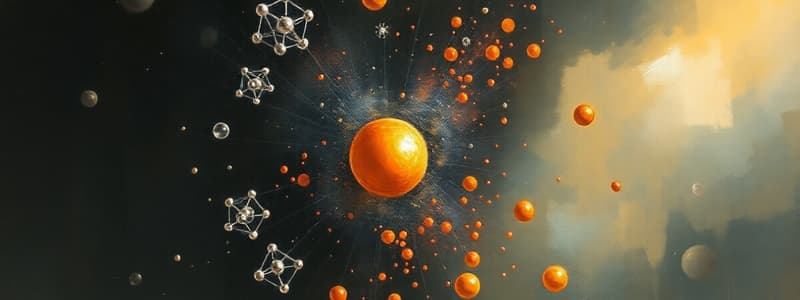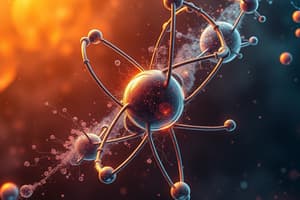Podcast
Questions and Answers
What is the smallest particle in an element called?
What is the smallest particle in an element called?
Atom
Electrons have a positive charge.
Electrons have a positive charge.
False (B)
What are the two types of particles found in the nucleus of an atom?
What are the two types of particles found in the nucleus of an atom?
- Electrons and protons
- Neutrons and protons (correct)
- Electrons and neutrons
- Neutrons and electrons
What is a nuclide?
What is a nuclide?
What is the atomic number (Symbol Z) of an atom?
What is the atomic number (Symbol Z) of an atom?
What is the nucleon number (Symbol A)?
What is the nucleon number (Symbol A)?
What is the unified atomic mass unit (Symbol: u) also known as?
What is the unified atomic mass unit (Symbol: u) also known as?
What is the mass number of an atom also referred to as?
What is the mass number of an atom also referred to as?
How are different nuclides identified?
How are different nuclides identified?
What are isotopes?
What are isotopes?
What are the three isotopes of hydrogen?
What are the three isotopes of hydrogen?
What are the two isotopes of chlorine?
What are the two isotopes of chlorine?
What is the isotopic mass?
What is the isotopic mass?
What is the relative isotopic mass?
What is the relative isotopic mass?
What is the atomic mass of an element?
What is the atomic mass of an element?
What is the relative atomic mass of an element?
What is the relative atomic mass of an element?
What are the two types of nuclear reactions?
What are the two types of nuclear reactions?
What is a fusion reaction?
What is a fusion reaction?
What are the three types of radiation emitted in nuclear reactions?
What are the three types of radiation emitted in nuclear reactions?
What is the charge of an alpha particle?
What is the charge of an alpha particle?
What is the charge of gamma radiation?
What is the charge of gamma radiation?
Alpha particles are attracted towards negatively charged surfaces
Alpha particles are attracted towards negatively charged surfaces
Beta particles are attracted towards positively charged surfaces
Beta particles are attracted towards positively charged surfaces
Gamma radiation is affected by an electric field.
Gamma radiation is affected by an electric field.
What is the key factor in balancing a nuclear equation?
What is the key factor in balancing a nuclear equation?
What does the activity of a radioactive substance refer to?
What does the activity of a radioactive substance refer to?
What is the half-life of a radioactive substance?
What is the half-life of a radioactive substance?
What is the key principle demonstrated by the graph showing the decrease of radiation over time?
What is the key principle demonstrated by the graph showing the decrease of radiation over time?
Flashcards
Atom
Atom
The smallest particle of an element.
Nucleus
Nucleus
The central part of an atom containing protons and neutrons.
Electron
Electron
A negatively charged particle orbiting the nucleus.
Neutron
Neutron
Signup and view all the flashcards
Proton
Proton
Signup and view all the flashcards
Nuclide
Nuclide
Signup and view all the flashcards
Atomic Number (Z)
Atomic Number (Z)
Signup and view all the flashcards
Nucleon Number (A)
Nucleon Number (A)
Signup and view all the flashcards
Unified Atomic Mass Unit (u)
Unified Atomic Mass Unit (u)
Signup and view all the flashcards
Isotopes
Isotopes
Signup and view all the flashcards
Isotopic Mass
Isotopic Mass
Signup and view all the flashcards
Relative Isotopic Mass
Relative Isotopic Mass
Signup and view all the flashcards
Atomic Mass
Atomic Mass
Signup and view all the flashcards
Relative Atomic Mass
Relative Atomic Mass
Signup and view all the flashcards
Nuclear Fusion
Nuclear Fusion
Signup and view all the flashcards
Nuclear Fission
Nuclear Fission
Signup and view all the flashcards
Alpha Particle
Alpha Particle
Signup and view all the flashcards
Beta Particle
Beta Particle
Signup and view all the flashcards
Gamma Ray
Gamma Ray
Signup and view all the flashcards
Half-life
Half-life
Signup and view all the flashcards
Activity
Activity
Signup and view all the flashcards
Balancing Nuclear Equations
Balancing Nuclear Equations
Signup and view all the flashcards
Protium
Protium
Signup and view all the flashcards
Deuterium
Deuterium
Signup and view all the flashcards
Study Notes
Atomic Structure
- Atoms are the smallest particles in an element.
- Atoms are made of a nucleus surrounded by electrons.
- Electrons have a negative charge (-1).
- The nucleus contains protons and neutrons.
- Protons have a positive charge (+1).
- Neutrons have no charge (0).
- Neutrons and protons can exist independently.
Nuclides
- A nuclide is an atomic species with a known number of protons and neutrons.
- The number of protons is equal to the number of electrons.
- The number of protons is called the atomic number (Z).
- The total number of protons and neutrons is called the mass number (A).
Isotopes
- Isotopes are nuclides of the same element with the same proton number but different neutron numbers.
- Elements are defined by their number of protons.
- Hydrogen has isotopes called protium, deuterium, and tritium.
- Chlorine has isotopes 35Cl and 37Cl.
- Isotopes have different masses, expressed in atomic mass units (u).
- The isotopic mass of 23Na is 23u.
- The atomic mass of an element is the average of the isotopic masses of its isotopes in a normal mixture.
- The atomic mass of chlorine is 35.5u.
Finding Atomic Mass
- The atomic mass of an element is the weighted average of the atomic masses of its isotopes.
- The weightings are based on the percentage of each isotope in a normal sample.
- Example calculation for potassium (K):
- 39K accounts for 93% of the sample.
- 41K accounts for 7% of the sample.
- Atomic mass of K = (0.93 x 39) + (0.07 x 41) ≈ 39.1 u
Finding Percentage of Isotope
- Example calculation for neon (Ne):
- The relative atomic mass of Ne (mixture of 22Ne and 20Ne) is 20.2 u.
- Assume the percentage of 20Ne is x%. Then (100-x)% is 22Ne.
- 20.2 = [(20 * x) + (22 * (100-x))] / 100
- Solving for x gives approximately 90%.
Nuclear Reactions
- Nuclear reactions involve changes in the nucleus of an atom.
- Two types are fusion (light nuclei combine) and fission (heavy nuclei split).
- Three types of radiation are emitted during nuclear reactions:
- Alpha particles (α): positive charge, relatively large mass, low penetration.
- Beta particles (β): negative charge, small mass, medium penetration.
- Gamma rays (γ): no charge, no mass, high penetration.
Balancing Nuclear Equations
- In nuclear reactions, the total mass number and atomic number must be equal on both sides of the equation.
- Example: U-238 decaying to Th-234.
Half-Life and Activity
- Activity is the rate of decay of a radioactive substance.
- Half-life is the time taken for half of the radioactive substance to decay.
Studying That Suits You
Use AI to generate personalized quizzes and flashcards to suit your learning preferences.
Related Documents
Description
Test your knowledge on atomic structure, nuclides, and isotopes with this quiz. Explore the fundamentals of atoms, including protons, neutrons, and the concept of isotopes. Challenge yourself to understand how atomic species relate to one another.




